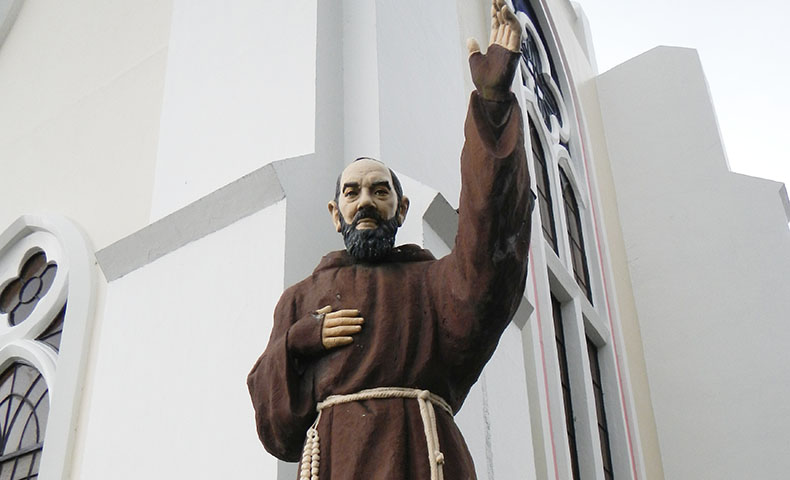San Pio da Pietrelcina, Saint of the day for 23 September

(25 May 1887 - 23 September 1968)
History of San Pio da Pietrelcina
In one of the largest ceremonies of this type in history, Pope John Paul II canonized Padre Pio of Pietrelcina on June 16, 2002. It was the 45th canonization ceremony of Pope John Paul II's pontificate. More than 300.000 people braved the scorching heat as they filled St. Peter's Square and nearby streets. They heard the Holy Father praise the new saint for his prayer and charity. "This is the most concrete synthesis of Padre Pio's teaching," the pope said. He also highlighted Padre Pio's testimony to the power of suffering. If accepted with love, the Holy Father stressed, such suffering can lead to "a privileged path of holiness".
Many people have turned to the Italian Capuchin Franciscan to intercede with God on their behalf; among them was the future Pope John Paul II. In 1962, when he was still archbishop in Poland, he wrote to Padre Pio and asked him to pray for a Polish woman with throat cancer. Within two weeks she was cured of her life-threatening illness.
Born Francesco Forgione, Padre Pio grew up in a peasant family in southern Italy. His father has worked twice in Jamaica, New York, to provide for the family income.
At the age of 15 Francesco joined the Capuchins and took the name of Pio. He was ordained a priest in 1910 and was drafted during the First World War. After he was found out that he had tuberculosis, he was discharged. In 1917 he was assigned to the convent of San Giovanni Rotondo, 120 km from the city of Bari on the Adriatic.
On September 20, 1918, while he was giving his thanks after mass, Padre Pio had a vision of Jesus. When the vision ended, he had stigmata in his hands, feet and side.
Life got more complicated after that. Doctors, ecclesiastical authorities and onlookers came to see Padre Pio. In 1924, and again in 1931, the authenticity of the stigmata was questioned; Padre Pio was not allowed to celebrate Mass publicly or hear confessions. He did not complain about these decisions, which were soon overturned. However, he wrote no letters after 1924. His only other writing, a pamphlet on the agony of Jesus, was done before 1924.
Padre Pio rarely left the convent after receiving the stigmata, but soon buses of people began to visit him. Every morning, after a 5 am mass in a crowded church, he listened to confessions until noon. He took a mid-morning break to bless the sick and all who came to see him. He also listened to confessions every afternoon. In time, his confessional ministry would take 10 hours a day; penitents had to take a number so that the situation could be handled. Many of them said that Padre Pio knew details of their life that they had never mentioned.
Padre Pio saw Jesus in all the sick and suffering. At his request, a beautiful hospital was built on nearby Mount Gargano. The idea was born in 1940; a committee has begun to raise money. The land was demolished in 1946. The construction of the hospital was a technical marvel due to the difficulty of obtaining water and transporting the building materials. This “House to relieve suffering” has 350 beds.
Several people have reported healings that they believe were received through the intercession of Padre Pio. Those who attended his masses went away edified; many onlookers were deeply moved. Like St. Francis, Padre Pio sometimes had his habit torn or cut by souvenir hunters.
One of Padre Pio's sufferings was that unscrupulous people repeatedly circulated prophecies that they claimed came from him. He never made prophecies about world events and never expressed an opinion on matters that he believed were up to the Church authorities to decide. He died on September 23, 1968 and was beatified in 1999.
Reflection
Referring to the Gospel of that day (Matthew 11: 25-30) in the Mass for the canonization of Padre Pio in 2002, St. John Paul II said: “The evangelical image of the 'yoke' evokes the many evidences that the humble Capuchin of St. Giovanni Rotondo had to endure. Today we contemplate in him how sweet Christ's "yoke" is and how light the burdens are every time someone carries them with faithful love. The life and mission of Padre Pio testify that difficulties and pains, if welcomed with love, are transformed into a privileged path of holiness, which opens the person towards a greater good, known only by the Lord ”.